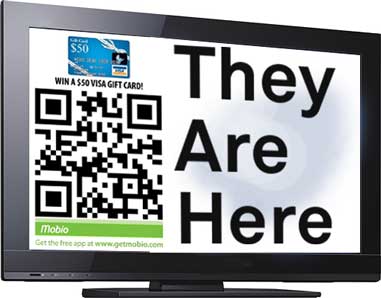QR Codes Turn TV into Point of Sale
 Mobio Pulls the Trigger on Broadcast Media
Mobio Pulls the Trigger on Broadcast Media
In an interview last week, Mark Binns, Chief Marketing Officer for Mobio Identity Systems, told me:
“It comes down to this: the TV couldn't sell you anything yesterday. Mobio's QR codes are empowering the couch potato. Any QR code becomes a point of sale.”
Mobio Identity Systems has just signed a 15 month exclusive contract with Shaw Media, operator of one of Canada's largest conventional TV networks, resulting in what just may be the biggest thing to happen to the QR code since the smartphone.
Simply stated, Shaw Media's advertisers may now incorporate Mobio QR codes into television commercials. The idea is to compel viewers into direct interaction with the brand from the comfort of their couches, turning the TV commercial into an interactive experience. But is the Couch Potato compelled to scan? Yes, they are. Ads with Mobio QR codes are showing a 15%-25% increase in brand interaction.
Brand interaction is a blanket term often applied to the ephemeral enjoyment a consumer may experience when a QR code takes them to 'exclusive video content' or a special mobile website. Not so here. Here it is concrete; serious, opt-in interaction like entering a contest, receiving a coupon or buying something. There is a true exchange of information between consumer and advertiser.
But why Mobio? Why aren't television advertisers using their own generic codes?
The difference between a generic QR code and a Mobio Code is like the difference between throwing a gun at someone and firing it. In the case of Mobio, the code is only the trigger; the power is in the platform.
“Mobio has been about the QR code since Day One,” Binns states, “We've always believed in the power of the distribution of the QR code. So we built a mobile commerce and mobile marketing platform with the QR code as a trigger.”
For the consumer, the platform allows for a seamless experience. The consumer uses the Mobio app to scan QR codes. Their data is stored in-app. This negates the necessity of repetitious data entry. This means you can scan five different codes from five different brands and never have to type any information. Literally, making a purchase with a scan.
For advertisers this means less abandoned mobile shopping carts. The abandonment rate for mobile shopping carts where the consumer is required to type his credit card information into his mobile phone is over 90%. With Mobio's PCI compliant platform, the consumer need only type their card's cvv number.
The platform also powers serious data collection. During the flow of purchase or marketing (contest, voting, coupons) the platform can collect any data requested by the brand; shoe size, favorite color, pet's name.
The generic code remains Mobio's primary competitor. Like other proprietary QR code platforms, such as Microsoft Tag, Mobio's biggest barrier may be education. The public is under-educated about the open source code versus the proprietary code. Mainly, the difference is that the generic code requires considerable back-end effort on the part of the brand to be effective. Remember: the QR code is merely a portal; it is the experience on the other side that makes the impact.
Choosing the Mobio platform means that an advertiser has instant access to in-app contests (Enter to Win— no external website support required), in-app voting (Who will be the next president?— no external website support required), coupon delivery straight to the consumer's smartphone and in-app payment processing that includes a shopping cart— no external ecommerce site or point of sale capability required.
As you read this, somewhere in Canada someone is pointing their smartphone at the TV and buying a sweater, or donating a dollar to charity with the hope of winning a trip to Spain. And while this may be the first big broadcast media partnership it will not be the last. Mobio has a vision and a plan. The partnership between Shaw and Mobio surfaced because Mobio got their attention with a beta trial on a local network. Already, Mobio has had extensive conversations with multiple US networks because if it works in Canada you can bet money it will work in the US.
If you liked this article, also try reading >> The Naked Truth about QR Codes
The Point of Sale News, an online magazine dedicated to the retail industry.

